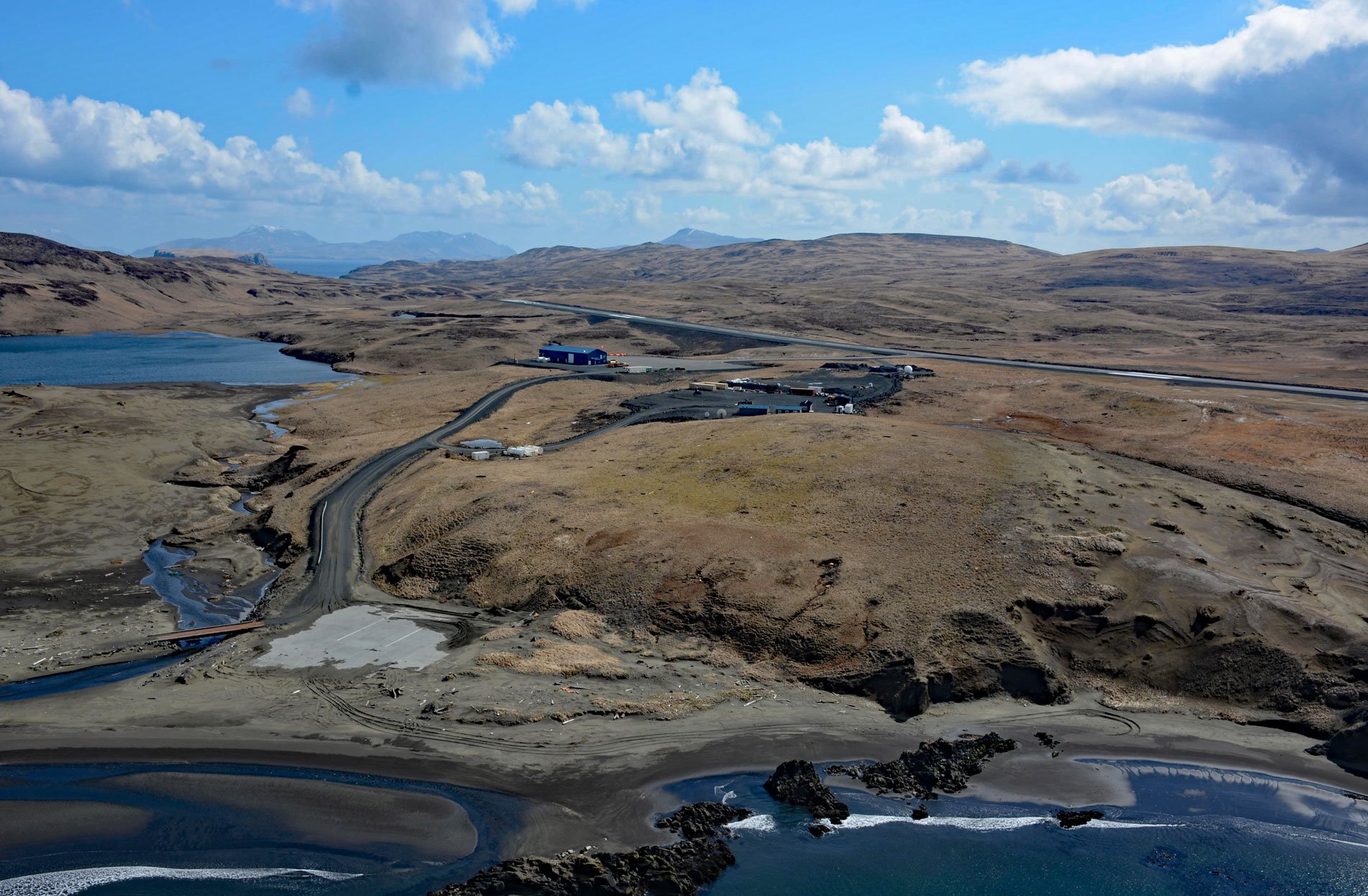Akutan Airport is a State of Alaska owned public-use airport on Akun Island that serves the community of Akutan which is 6 miles (10 km) west-southwest across Akutan Bay on Akutan Island, about 766 miles (1,235 km) southwest of Anchorage and 44 miles (71 km) northeast of Dutch Harbor, Alaska. Akun Island is relatively flat and uninhabited, except for airport workers and a few people controlling a herd of feral cattle. The island historically had three small villages or seasonal camps. The Alutiiq Unangan name was recorded in 1768 by Captain Lieutenant P.K. Krenitzin of the Imperial Russian Navy. According to the linguist R.H. Geoghegan, the name Akun means “that, over there”. Neighboring Akutan Island is mountainous and the topography is dominated by Mount Akutan, a stratovolcano with an elevation of 4,275 feet (1,303 m) that last erupted in 1992. The name Akutan may be from the Alutiiq word “hakuta” which, according to R.H. Geoghegan, means “I made a mistake”. The community of Akutan is made up of two separate populations. One is the native Aleut Unangan village that remains closely tied to their cultural heritage with approximately 75 residents. The other is the seasonal workforce associated with the Trident Seafoods shore plant. The remote processing facility operates year-round and can house as many as 825 employees. There is little interaction between the two populations although they are counted together statistically as residents of Akutan. Trident Seafoods is the largest seafood company in the United States. It is owned by ConAgra and based in Seattle, Washington. It manages a network of fishing ships, processing plants, and seafood product distribution networks that sell frozen, canned, smoked and ready-to-eat products for the wholesale, retail and food service markets under a variety of different brand names.
Akutan was established in 1878 as a fur storage and trading post for the Western Fur & Trading Company. The company’s agent established a commercial cod fishing and processing business that quickly attracted nearby Alutiiq people to the community. A Russian Orthodox church and a school were built in 1878 but the church was replaced in 1918 by the Saint Alexander Nevsky Chapel. In 1883, the Alaska Commercial Company purchased the trading post. The Pacific Whaling Company built a whale processing station across the bay from Akutan in 1912. It was the only whaling station in the Aleutians and operated until 1939. After the Empire of Japanese attacked Dutch Harbor in June 1942, the U.S. military evacuated Akutan residents to the Ketchikan area. The village was re-established in 1944, although many villagers chose not to return. The community is very isolated and can only be accessed by air or by sea. Between the months of April and October, the Alaska State Ferry stops on its westbound voyage prior to stopping at Dutch Harbor, then again on its eastbound voyage from Dutch Harbor to Homer. Cargo is delivered weekly by freighter from Seattle. For many decades, the only commercial aircraft serving Akutan was a World War II-era amphibious Grumman Goose that could accommodate eight passengers and minimal freight per flight. Because the aircraft was restricted to visual flight rules and had to land in the harbor and then taxi to shore and up a ramp in town, flights were frequently canceled. The age and operating costs of that aircraft led community officials to start planning a new airport in 1999. The community of Akutan is a member of the Aleutian Pribilof lslands Community Development Association, a nonprofit corporation participating in the Western Alaska Community Development Quota, known as the CDQ. The CDQ program was created by the North Pacific Fisheries Management Council in 1992 to provide western Alaska communities an opportunity to participate in the Bering Sea and Aleutian Islands fisheries that had been foreclosed to them because of the high capital investment needed to enter the fishery. The program allocates 10 percent of all Bering Sea and Aleutian Islands quotas for groundfish, prohibited species, halibut, and crab to eligible communities. The purpose of the CDQ Program is to provide eligible western Alaska villages with the opportunity to participate and invest in fisheries in the Bering Sea and Aleutian Islands Management Area, to support economic development in western Alaska, to alleviate poverty and provide economic and social benefits for residents of western Alaska, and to achieve sustainable and diversified local economies in western Alaska. This provided the justification for Trident to build and operate a seafood processing facility at Akutan and to provide the facility with better transportation options.
The steep terrain on volcanic Akutan Island presented engineering obstacles for a new airport, so planners looked to Akun Island as an alternative site. After about ten years of investigation, studies, assessments, and meetings, the Akutan Airport Construction Project was awarded to Kiewit Infrastructure West Company and began on Akun Island in March of 2010. In 2012, the facility included a paved runway of 4,500 feet (1.4 km), a taxiway, an apron, a sand storage building, a snow removal equipment building, a hovercraft maintenance and storage facility, three hovercraft landing pads, an access pad, and surrounding access roads. A hotel and restaurant were also constructed to provide for stranded passengers. The federal budget slated for the project was $54 million. In addition to the airport on Akun Island, a new harbor with a hovercraft storage facility, pad, and ramp were constructed on Akutan Island by Knik Construction Company for $32 million. The connection between Akun and Akutan across the 6 miles (10 km) of Akutan Bay was provided for a few years by a BHT-130WD hovercraft but it was unable to safely operate in high winds and rough seas, so it was often grounded. Ultimately, the hovercraft was too expensive to operate and a helicopter is now used to shuttle passengers and cargo. Scheduled air service to Akutan from Anchorage is subsidized by the Essential Air Service program. Read more here and here. Explore more of the Akutan Airport and Akun Island here:

